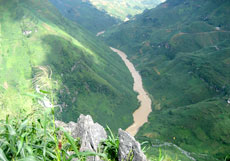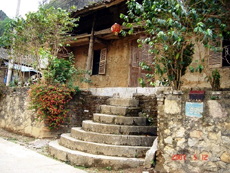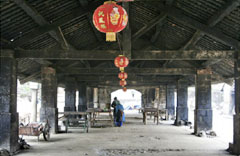
Along all 160-km road from Ha Giang Town to Dong Van Stone Plateau with a rocky wall on one side, travelers will have chance to contemplate a sea of very sharp-pointed and steep rugged rocks, which are tottery with the average 1,000 to 1,600m above the sea level.
Among this vast stone plateau, travelers can see unlimited quantity of rock, sometimes can meet only a few ethnic minority people carrying firewood, grass or vegetable or cattle home. However, passing through the stone plateau, Dong Van Town suddenly appears amongst mountains and clouds as a charming mountain girl.
Strolling on a road lined with beautiful old houses in the early morning or late afternoon is a popular pastime of many travelers who have spent a night in Dong Van Town.
The old houses have earned a reputation for the northern town thanks to their unique structures that highlight the distinctive culture and life characteristics of the local people.
Typically the traditional residence of the H’mong people consist of simple roofs, three separate sections, one front door and one side door, high windows, simply-carved poles and thick walls. The H’mong people build the walls by putting wet clay in molds and compressing it into the walls they want. The thick soil walls keep the house cool when it is hot and warm in the winter time.

While the house of the Kinh people in Dong Van was built of wood with a little garden, beautifully-carved stone gate and other components featuring their culture.
Despite some different architectural characteristics, the old houses of different peoples share something in common and constitute a harmonious setting in the surrounding environment.
Most of the buildings were roofed with double clay-baked tiles, which keep the houses warm in chilly days of the mountainous region and cool in the dry season according to the locals. The tiles have become a deep brown over the years on some of the 40 houses which have stood in the little town for more or less 100 years. The oldest residence is said to be 200 years.
The houses and buildings in Dong Van Market form an old quarter that has won the admiration of scholars and tourists from near and far.
Even though many things have changed since the French arrived in Dong Van in 1887, the people still keep their traditional festivals and follow their social practices.
In the wee hours on Sunday mornings, H’mong, Tay and other ethnic minority people from Dong Van and other parts of Ha Giang Province dress up their colorful costumes and walk to Dong Van Market to sell and buy all kinds of goods.

Ethnic minority females sell brocade (
tho cam - ethnic fiber), clothes, animals, domestic fowl, vegetables, pork, beef, fruits and food they have raised or made. Meanwhile, the men go to the once-a-week original market to drink and converse with others.
The street of old houses is radiant on the fourteenth and fifteenth days of the lunar calendar when locals hang red lanterns in front of their residences. On those days of the month festivals feature music and singing, dances and art shows by various peoples. If possible tourists should arrange their trips to Dong Van on full-moon days and Sundays when the quiet town comes alive.
Ancient town of Dong Van is an interesting destination in the far north of Viet Nam, where the long-standing customs, practices and unique intangible cultural values of the ethnic groups are still preserved. These precious values are awakening to attract more tourists to Dong Van.
Phuong Anh (Edited)